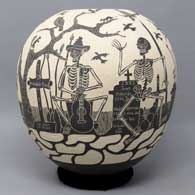
Click or tap to see a larger version
Alfredo Rodriguez, Mata Ortiz and Casas Grandes, A black and white jar with sgraffito Day of the Dead design
Mata Ortiz and Casas Grandes
$ 550
aqcgd9181
A black and white jar with sgraffito Day of the Dead design
7.5 in H by 6.5 in Dia Measurement includes stand
Condition: Excellent
Signature: Alfredo Rodriguez Freddy
Date Created: 2019
Tell me more! Buy this piece!
(505) 986-1234 - www.andreafisherpottery.com - All Rights Reserved
Alfredo Rodriguez
"Freddy"
Mata Ortiz &Casas Grandes
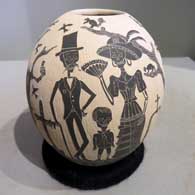
Alfredo Freddy Rodriguez is a potter from the village of Mata Ortiz in northern Mexico. He most likely learned how to make pottery from his cousin, Armando Rodriguez, but his early work also showed a significant influence from another cousin: Manuel Manolo Rodriguez.
More recently, Freddy has been producing a lot of black and white sgraffito Day of the Dead and Night of the Dead designs on his pots, in addition to his contemporary black-on-beige painted designs.
Alfredo is married to potter Diana Loya and they often collaborate on their projects. She learned how to do sgraffito work from Alfredo. They live in the Barrio Americano neighborhood in Mata Ortiz.
Alfredo and Diana taught their son, Emiliano Rodriguez, to make pottery, too. He also likes to make sgraffito designs, although he's developed designs that are a bit different from those of his folks. Later Diana taught her mom, Maria Saenz, how to make pottery.
Mata Ortiz and Casas Grandes
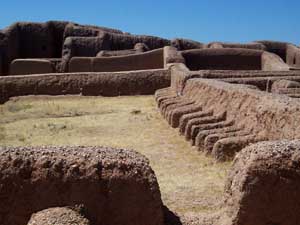
The macaw pens at Paquimé
Casas Grandes is both a municipality and an archaeological district in northern Chihuahua State, Mexico. The archaeological district includes the pre-historic ruins of Paquimé, a city that began to build around 1130 AD and was abandoned about 1450 AD. Archaeologists are uncertain as to whether Paquimé was settled by migrants from the Mogollon/Mimbres settlements to the north or by Anasazi elite from the Four Corners region in the United States or by others. Over the years Paquimé was built into a massive complex with structures up to six and seven stories high with multiple Great Houses in the surrounding countryside. Today, the site is a UNESCO World Heritage Site.
Mata Ortiz is a small settlement inside the bounds of the Casas Grandes municipality very near the site of Paquimé. The fortunes of the town have gone up and down over the years with a real economic slump happening after the local railroad repair yard was relocated to Nuevo Casas Grandes in the early 1960's. The town was in steady decline until Juan Quezada, a poor farmer who gathered firewood in the area of the archaeological site, was inspired by fragments of ancient Paquimé pottery and even older fragments of Mimbres forms with bold black-on-white designs littering the ground to learn more.
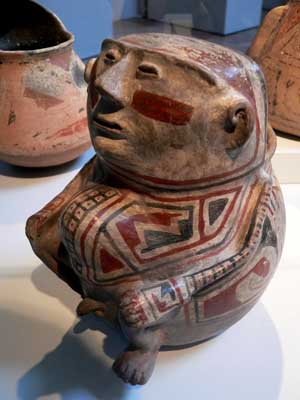
Ramos Polychrome effigy pot from Paquimé
Quezada was successful in his quest to learn to recreate the ancient process using slightly more modern techniques (although no one in the present tradition uses a potter's wheel). He learned to use sand and other coarse materials for temper. He discovered that dried cow dung made an excellent and inexpensive firing fuel. Instead of using gourds for smoothing he substituted broken hacksaw blades. Instead of using yucca fiber brushes for painting he learned to make brushes with human hair. He persevered in his efforts and by 1971 had produced a kind of polychrome pottery. Since then, most pottery-making in the area has used innovations in the design and decoration of the pots but the materials and the basic crafting of the process have remained the same.
By the mid-1970s, Quezada had attracted a significant number of traders and his work was becoming a commercial success. That is when he began teaching his techniques to his immediate family. They in turn taught other family members, friends and the younger generations. Both women and men were included from the beginning.
Originally called Casas Grandes pottery in the early years of its production, the potters of this tiny village have made such an impact on the pottery communities, including many awards and special recognition from the Presidents of Mexico, that Mata Ortiz pottery is now becoming known around the world.
Today, pottery production has changed the village in many ways as there is now electricity, plumbing, vehicles and more for the residents. Virtually everyone in the small town (2010 population: 1,182) makes their living by working in some part of the pottery-making process, from potters to clay-gatherers to firewood collectors to traders.
Mata Ortiz pottery incorporates elements of contemporary and prehistoric design and decoration, and each potter or pottery family produces their own distinctive, individualized ware. Young potters from surrounding areas have been attracted to the Mata Ortiz revival and new potting families have developed while the art movement continues to expand. Without the restraints of traditional religious practices or gender constraints, a vibrant flow of new ideas has enabled the pottery of Mata Ortiz to avoid the derivative repetition common to virtually all folk art movements. This blend of economic need, gender equality, cultural expression and artistic freedom has produced a unique artistic movement in today's community.

Lower photo is courtesy of David Monniaux, Creative Commons Attribution-Share Alike 3.0 Unported License
Day of the Dead
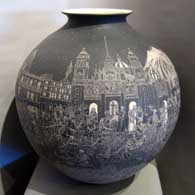
Mata Ortiz
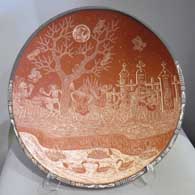
Mata Ortiz
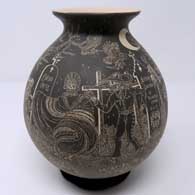
Mata Ortiz
The Day of the Dead, El Dia de los Muertos, is a holiday celebrated in Mexico where ancient Aztec rituals going back more than 2,500 years are merged with Catholic beliefs brought by the Spaniards in the 1500s. The holiday is about honoring the ancestors with food, drink, parties and other activities designed to include the ancestors' spirits in today's daily life. Families also set up ofrendas (private altars) to honor their ancestors.
Death is considered an integral part of the continuum of life and, as such, is not to be feared. Celebrations occur November 1 (All Saints Day) when adult spirits come to visit, and November 2 (All Souls Day) when families go to the cemetery to decorate the graves of their loved ones. This is a very colorful holiday with marigolds, cardboard skeletons, sugar skulls, incense and tissue paper decorations in riotous colors everywhere.
Depictions of Day of the Dead activities is a motif explored by several renowned potters from the village of Mata Ortiz in Chihuahua, Northern Mexico. Premier among them is Hector Javier Martinez who originated the style in 2008 after searching for "something different" to help him secure pottery making as a vocation. He has since won several major awards for his Day of the Dead (and Night of the Dead) pottery, the very prestigious Presidencial Award from the Mexico National Ceramics Concourso in Tlaquepaque among them. Alfredo Rodriguez, Diana Loya, Martin Corona, Adrian Corona and Emiliano Rodriguez are some of the other Mata Ortiz artists using Day of the Dead and Night of the Dead motifs as inspiration for their own creations.

Mata Ortiz

Mata Ortiz

Mata Ortiz
Manuel Rodriguez Family and Teaching Tree - Mata Ortiz
Disclaimer: This "family tree" is a best effort on our part to determine who the potters are in this family and arrange them in a generational order. The general information available is questionable so we have tried to show each of these diagrams to living members of each family to get their input and approval, too. This diagram is subject to change should we get better info.
- Manuel Manolo Rodriguez Guillen (1972- )
- Ricardo Delgado Cruz & Sandra Lorena Arras
- Marta Gonzalez
- Ismael Flores Ledezma
- Ismael Flores Jr.
- Arturo Ledezma
- Efren Ledezma
- Juana Ledezma
- Rafael Ledezma
- Santos Ledezma & Rosa Loya
- Leticia Ledezma
- Leonel Lopez Sr. & Elena Rodriguez de Lopez
- Abel Lopez
- Leonel Lopez Jr.
- Uriel Lopez and Jesus Rodriguez Guillen
- Maribel Lopez
- Oralia Lopez
- Rosalba Lopez
- Yesenia Lopez
- Hugo Macias
- Alfredo Freddy Rodriguez & Diana Loya
- Emiliano Rodriguez Loya
- Armando Rodriguez & Olivia Mora de Rodriguez
- Abraham Rodriguez
- Luis Armando Rodriguez
- Graciela (Martinez) Gallegos & Hector Gallegos Sr.
- Guadalupe Gallegos (student)
- Hector Gallegos Jr. & Laura Bugarini
- Miriam Gallegos Martinez
- Julio Mora (1971-) & Alma Soto (1974-)
- Leticia Rodriguez Mora
- Oscar Rodriguez Guillen (1970-)
- Ruben Rodriguez & Martha Ponce de Rodriguez
- Teresa Tere Rodriguez
Copyright © 1998-2025 by


